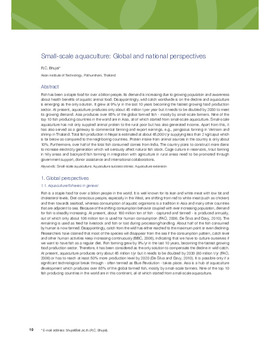Small-scale aquaculture: Global and national perspectives

Citation
Bhujel, R.C. (2012). Small-scale aquaculture: Global and national perspectives. p. 10-18. In: Shrestha, M.K. ; Pant, J. (eds.) Small-scale aquaculture for rural livelihoods: Proceeding of the National Symposium on Small-scale Aquaculture for Increasing Resilience of Rural Livelihoods in Nepal. Institute of Agriculture and Animal Science, Tribhuvan University, Rampur, Chitwan, Nepal and the WorldFish Center. Penang, Malayisa
Fish has been a staple food for over a billion people. Its demand is increasing due to growing population and awareness about health benefits of aquatic animal food. Disappointingly, wild catch worldwide is on the decline and aquaculture is emerging as the only solution. It grew at 9%/yr in the last 10 years becoming the fastest growing food production sector. At present, aquaculture produces only about 45 million t per year but it needs to be doubled by 2030 to meet its growing demand. Asia produces over 85% of the global farmed fish - mostly by small-scale farmers. Nine of the top 10 fish producing countries in the world are in Asia, all of which started from small-scale aquaculture. Small-scale aquaculture has not only supplied animal protein to the rural poor but has also generated income. Apart from this, it has also served as a gateway to commercial farming and export earnings, e.g., pangasius farming in Vietnam and shrimp in Thailand. Total fish production in Nepal is estimated at about 45,000 t/yr supplying less than 2 kg/caput which is far below as compared to the neighboring countries. Protein intake from animal sources in the country is only about 10%. Furthermore, over half of the total fish consumed comes from India. The country plans to construct more dams to increase electricity generation which will seriously affect natural fish stock. Cage culture in reservoirs, trout farming in hilly areas and backyard fish farming in integration with agriculture in rural areas need to be promoted through government support, donor assistance and international collaborations.
Permalink
Date Available
Type
Publisher
Copyright
CC BY 4.0
Research Themes
Language